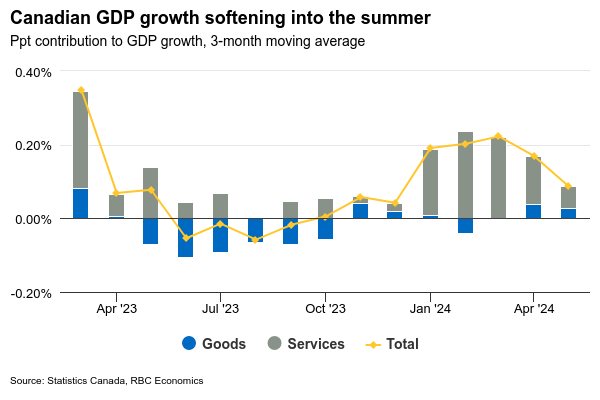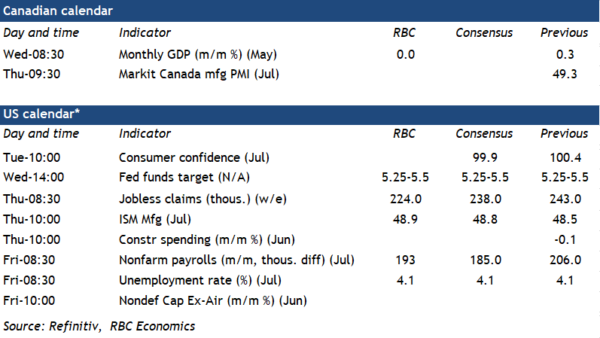The week ahead is a busy one on the data calendar with the release of Canada’s gross domestic product for May and the U.S. Federal Reserve’s decision on interest rates on Wednesday, followed by U.S. payroll employment data on Friday.
Canadian GDP data should continue to point to a weakening economy in Q2. We expect momentum faded in May with output growth unchanged after a stronger 0.3% increase in April. That’s slightly more pessimistic than Statistics Canada’s preliminary estimate for a 0.1% increase, but more in line with early industry readings that flagged a decline in wholesale and retail sales. In June, GDP growth likely weakened further, dipping to an outright contraction. Total hours worked fell by 0.6%, and manufacturing sales contracted by 2.6%. Overall, those monthly readings should leave the Q2 quarterly GDP at an annualized 1.5% from Q1. That’s in line with our tracking of 1.4% and the Bank of Canada’s forecast of 1.5% in their latest July Monetary Policy Report and should point to another decline in output per-capita in Q2 once the increase in population is accounted for.
In the U.S., we expect no change in key interest rate from the Fed’s meeting next Wednesday. Chairman Jerome Powell had refrained from giving any guidance on future policy moves in the last few meetings and other speaking engagements. Instead, he has focused on the central bank’s assessment that employment and inflation risks are moving into a better balance—but just not to the point that would spur interest rate cuts. There is the risk of a slightly more dovish lean, given the progress with consumer price index readings in the summer alongside normalization in the labour market backdrop. The core PCE price index in the U.S. dropped to an annualized 2.9% in Q2 from 3.7% in Q1, in line with slowing in CPI data in May and June. Labour market conditions have softened, with employment growth trending broadly lower and the unemployment rate edging higher – although both to levels that would still be considered historically robust. We expect Friday’s U.S. labour market data will show another 193,000 increase in employment in July, and the unemployment rate staying at 4.1%.
Week ahead data watch














